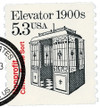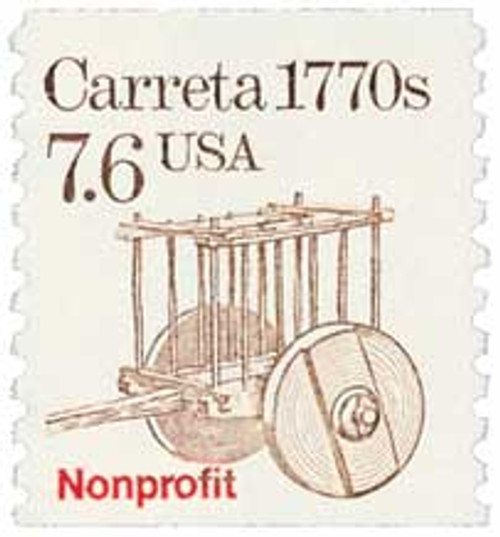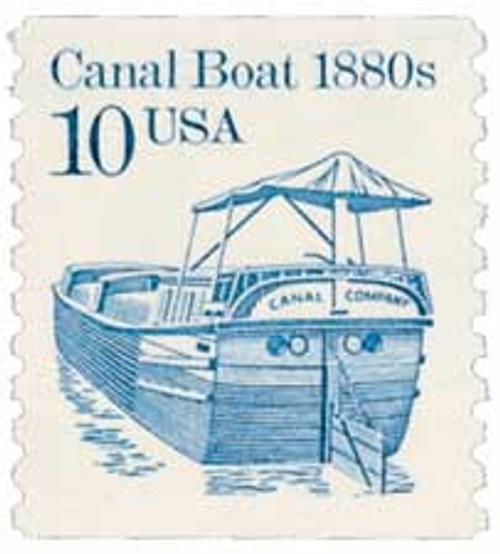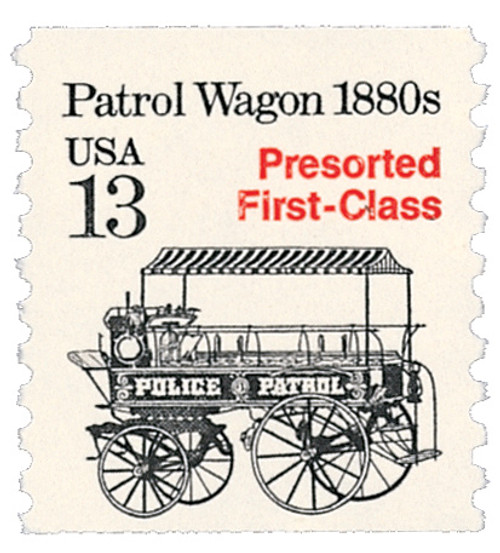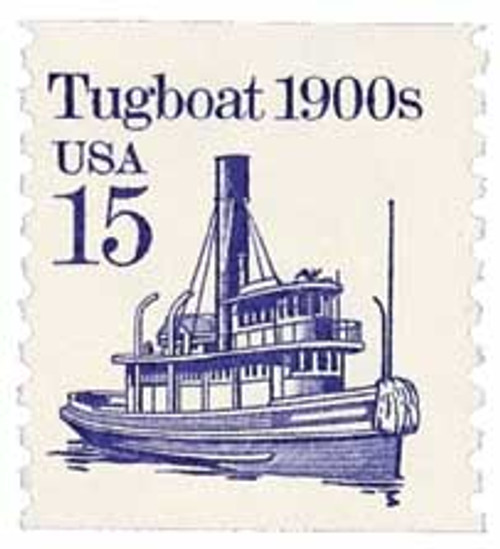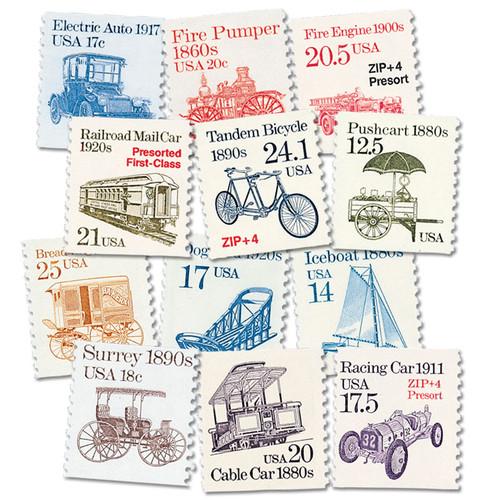
# 2254 - 1988 5.3c Transportation Series: Elevator, 1900s
U.S. #2254
1988 5.3¢ Elevator, 1900s
Transportation Series
- First Transportation Series stamp depicting a vehicle that doesn’t use wheels, runners, or float
Stamp Category: Definitive
Series: Transportation
Value: 5.3¢, nonprofit carrier route sort rate
First Day of Issue: September 16, 1988
First Day City: New York, New York
Quantity Issued: 280,792,000
Printed by: Bureau of Engraving and Printing
Printing Method: Engraved
Format: Coils of 500 and 3,000
Perforations: 10 vertical
Color: Black
Why the stamp was issued: In 1988, the carrier route presort rate for nonprofit organizations was reduced from 5.5¢ to 5.3¢ – a rare occasion in which a rate was lowered instead of increased. This stamp replaced the old 1986 5.5¢ Star Route Truck stamp.
The selection of the elevator as this stamp’s subject drew some criticism. It had been included in a list of humorous suggestions from readers of Linn’s Stamp News. The stamp’s announcement was received by jeers and jokes, with some saying they “felt a tad let down,” and that they USPS was “giving the shaft” to ships and aircraft by honoring the elevator instead of those more traditional forms of transportation. However, some supported the USPSs’ choice, noting that elevators helped cities to grow and that the elevator is “arguably the most significant of all in its impact.”
About the stamp design: Lou Nolan produced the pen and ink drawing of the early 1900s elevator pictured on this stamp. He created his image based on several photos and plans provided by the Otis Elevator Company.
Special design details: This stamp has a “Nonprofit Carrier Route Sort” precancel. Precancels are stamps canceled before being sold, to make mailing faster and cheaper for customers with large amounts of mail. Bulk mailers use precancels, then pre-sort their mail and save money.
First Day City: The First Day ceremony for this stamp was held at the Waldorf Astoria Hotel in New York City. During the ceremony, the postmaster general remarked that the USPS and elevator companies “are destined to provide a service that people remember most for their lapses, however few and far between.” He went on to say “Stories about the proverbial letter that took forever stand alongside tales about the time we were stuck forever in an elevator. The truth is that mail service and elevators both work remarkably well. Mailing a letter or taking an elevator should be second nature. Both systems have earned our trust and confidence.”
About the Transportation Series: On May 18, 1981, the USPS issued the first stamp in the Transportation Series, US #1907, picturing the Surrey, a doorless four-wheeled carriage. For the first time in US history, a coil stamp featured its own unique design rather than simply copying that of the current definitive stamp. Over 50 more coil stamps would be issued over the course of the next 15 years, each picturing a different mode of transportation. All of these types of transportation were used since American independence.
The various denominations provided face values to exactly match the rates for several categories of Third-Class mail (bulk rate and quantity-discounted mail). As the rates changed, new stamps with new values were added. Never before had a stamp series included so many fractional cent values.
The Bureau of Engraving and Printing printed most of the stamps in the Transportation Series, although private contractors printed a few. All but a few of the later stamps were produced by engraved intaglio. Differences in precancels, tagging, paper and gum provide a large number of varieties.
Scott Catalog separates the Transportation stamps into four groups. The stamps in the first group (#1897-1908) generally have the denomination in small type with a “c” next to it. These stamps were printed on the Cottrell rotary press, which joined together two plates to make a sleeve. The gaps between these plates created depressions where ink would collect and create joint lines on the stamps. Later issues were printed on a different press and didn’t have these joint lines.
The second group (#2123-36) had larger numbers with no “c.” The third group (#2252-66) was similar in appearance to the second group, but service inscriptions were added to the designs. These stamps also used a variety of paper and gum as well as different types of tagging. The fourth group (#2451-68) marked the end of fractional values. Now bulk mailers would use either the 5¢ or 10¢ stamp and then pay the difference from the actual postage rate.
The last stamp in the Transportation Series, the 20¢ Cog Railway, was issued on June 9, 1995, at the TEXPEX ’95 stamp show in Dallas, Texas. This marked the end of the largest US definitive series up to that time. Three new series would eventually replace it – American Transportation, American Culture, and American Scenes. Additionally, the Great Americans would go on to become the largest American definitive series.
History the stamp represents: Although elevators are restricted in their range of travel, during the past century and a half they have greatly improved the way we live and work. As Lawrence J. Gavrich of Otis Elevator Company pointed out, "...Without the elevator...cities would not have been able to grow up as well as out...and structures like the Eiffel Tower and Empire State Building would be the stuff of science fiction.
U.S. #2254
1988 5.3¢ Elevator, 1900s
Transportation Series
- First Transportation Series stamp depicting a vehicle that doesn’t use wheels, runners, or float
Stamp Category: Definitive
Series: Transportation
Value: 5.3¢, nonprofit carrier route sort rate
First Day of Issue: September 16, 1988
First Day City: New York, New York
Quantity Issued: 280,792,000
Printed by: Bureau of Engraving and Printing
Printing Method: Engraved
Format: Coils of 500 and 3,000
Perforations: 10 vertical
Color: Black
Why the stamp was issued: In 1988, the carrier route presort rate for nonprofit organizations was reduced from 5.5¢ to 5.3¢ – a rare occasion in which a rate was lowered instead of increased. This stamp replaced the old 1986 5.5¢ Star Route Truck stamp.
The selection of the elevator as this stamp’s subject drew some criticism. It had been included in a list of humorous suggestions from readers of Linn’s Stamp News. The stamp’s announcement was received by jeers and jokes, with some saying they “felt a tad let down,” and that they USPS was “giving the shaft” to ships and aircraft by honoring the elevator instead of those more traditional forms of transportation. However, some supported the USPSs’ choice, noting that elevators helped cities to grow and that the elevator is “arguably the most significant of all in its impact.”
About the stamp design: Lou Nolan produced the pen and ink drawing of the early 1900s elevator pictured on this stamp. He created his image based on several photos and plans provided by the Otis Elevator Company.
Special design details: This stamp has a “Nonprofit Carrier Route Sort” precancel. Precancels are stamps canceled before being sold, to make mailing faster and cheaper for customers with large amounts of mail. Bulk mailers use precancels, then pre-sort their mail and save money.
First Day City: The First Day ceremony for this stamp was held at the Waldorf Astoria Hotel in New York City. During the ceremony, the postmaster general remarked that the USPS and elevator companies “are destined to provide a service that people remember most for their lapses, however few and far between.” He went on to say “Stories about the proverbial letter that took forever stand alongside tales about the time we were stuck forever in an elevator. The truth is that mail service and elevators both work remarkably well. Mailing a letter or taking an elevator should be second nature. Both systems have earned our trust and confidence.”
About the Transportation Series: On May 18, 1981, the USPS issued the first stamp in the Transportation Series, US #1907, picturing the Surrey, a doorless four-wheeled carriage. For the first time in US history, a coil stamp featured its own unique design rather than simply copying that of the current definitive stamp. Over 50 more coil stamps would be issued over the course of the next 15 years, each picturing a different mode of transportation. All of these types of transportation were used since American independence.
The various denominations provided face values to exactly match the rates for several categories of Third-Class mail (bulk rate and quantity-discounted mail). As the rates changed, new stamps with new values were added. Never before had a stamp series included so many fractional cent values.
The Bureau of Engraving and Printing printed most of the stamps in the Transportation Series, although private contractors printed a few. All but a few of the later stamps were produced by engraved intaglio. Differences in precancels, tagging, paper and gum provide a large number of varieties.
Scott Catalog separates the Transportation stamps into four groups. The stamps in the first group (#1897-1908) generally have the denomination in small type with a “c” next to it. These stamps were printed on the Cottrell rotary press, which joined together two plates to make a sleeve. The gaps between these plates created depressions where ink would collect and create joint lines on the stamps. Later issues were printed on a different press and didn’t have these joint lines.
The second group (#2123-36) had larger numbers with no “c.” The third group (#2252-66) was similar in appearance to the second group, but service inscriptions were added to the designs. These stamps also used a variety of paper and gum as well as different types of tagging. The fourth group (#2451-68) marked the end of fractional values. Now bulk mailers would use either the 5¢ or 10¢ stamp and then pay the difference from the actual postage rate.
The last stamp in the Transportation Series, the 20¢ Cog Railway, was issued on June 9, 1995, at the TEXPEX ’95 stamp show in Dallas, Texas. This marked the end of the largest US definitive series up to that time. Three new series would eventually replace it – American Transportation, American Culture, and American Scenes. Additionally, the Great Americans would go on to become the largest American definitive series.
History the stamp represents: Although elevators are restricted in their range of travel, during the past century and a half they have greatly improved the way we live and work. As Lawrence J. Gavrich of Otis Elevator Company pointed out, "...Without the elevator...cities would not have been able to grow up as well as out...and structures like the Eiffel Tower and Empire State Building would be the stuff of science fiction.









